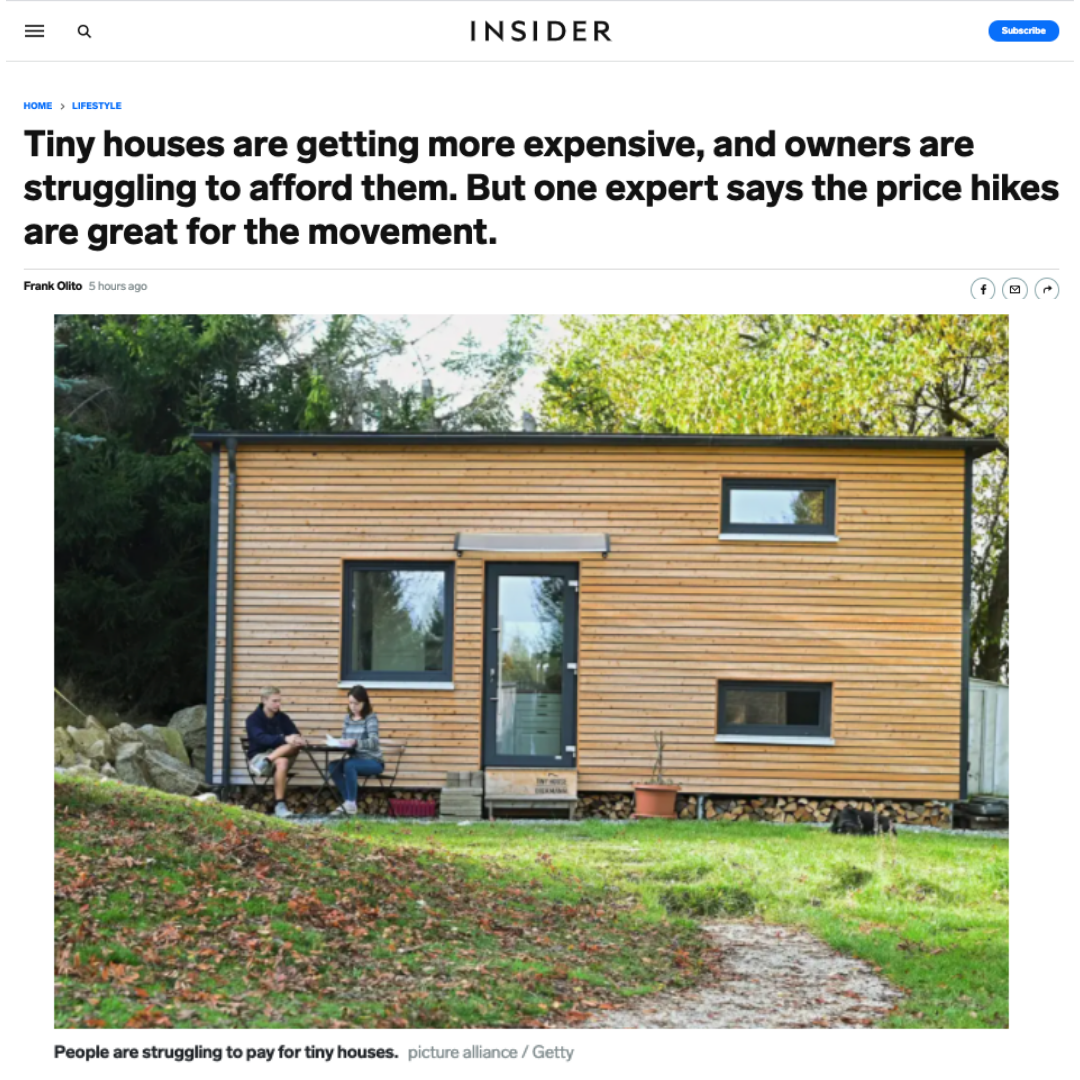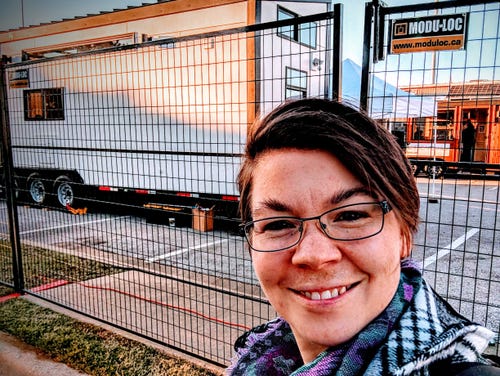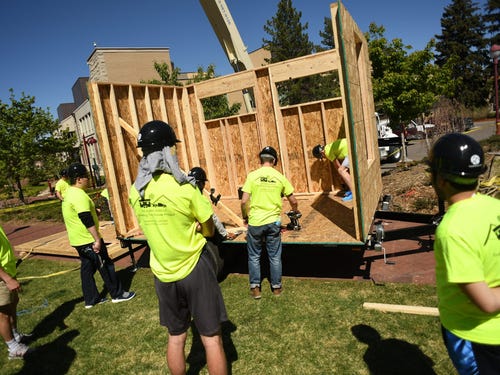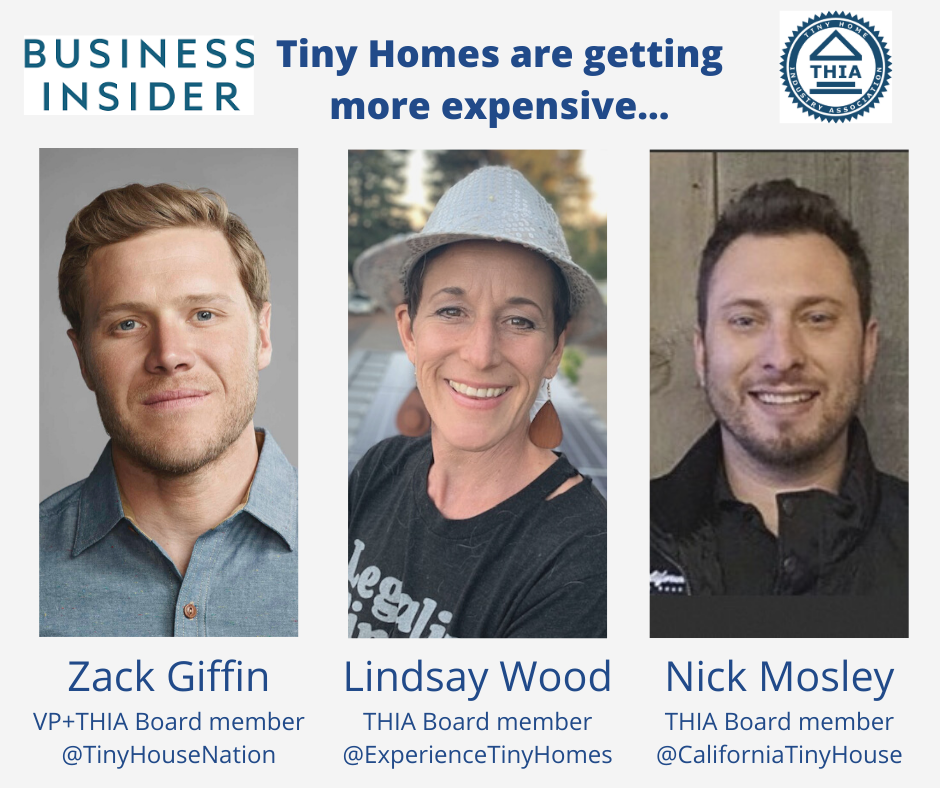|
Frank Olito, March 26, 2021 In 2016, Carley Jackson was living in Louisiana when a natural disaster flooded half the state. With her apartment destroyed, she was forced to move into a hotel for a month. At that moment, Jackson decided to fast-track her dream of living in a tiny house, something she had been fantasizing about for a decade. She moved to Austin — a more tiny-house-friendly city — in 2019, and while there, she saved as much money as she could for her future home. But, in 2021, Jackson learned her tiny-house dreams may not become a reality. Based on past tiny-house costs she'd found in her research, Jackson saved $50,000 and thought she had enough to finally start building her home. She worked with a consultant to design a basic 26-foot tiny house with a downstairs bedroom, lots of storage, and a dishwasher for herself, her boyfriend, and their dog. When they began pricing builders, Jackson was surprised to learn their tiny house would actually cost $70,000 to $80,000. Jackson was about $30,000 short. "It was shocking," Jackson said. "You plan something and you have a dream in your head, and then it all falls apart. It's extremely frustrating." Jackson isn't alone. Potential tiny-house owners across the country are frustrated with the growing cost of tiny houses and are being forced to give up their dreams of joining the movement. The prices of tiny houses today are vastly different than they were a decade ago When the modern tiny-house movement started in the early 2000s, it was advertised as an affordable way to own a home. Shows like "Tiny House Nation," which premiered in 2014, perpetuated the idea that people could buy a tiny house for cheap, but as the movement took off, those cheaper homes became less of a reality. "In the very beginning, I don't think anyone knew exactly how much the homes we were building on 'Tiny House Nation' cost," Zack Giffin, host of the series, told Insider. "The homeowners would have a set budget and we would deliver a home regardless. The product integrations and the labor from myself and my crew were never even calculated." The median cost of a tiny house today is around $60,000, and the price keeps climbing as the demand for these smaller structures increases and builders push the boundaries of what a tiny house can look like. David Latimer of New Frontier Design, for example, created the Escher, a family-friendly tiny house that starts at $180,000. It includes a chef's kitchen, two bedrooms, a modern bathroom, and a walk-in closet. Although the Escher house is far from where the movement started, some say this is where the movement is heading. However, the price for tiny houses without high-end amenities — like Jackson's proposed design — is also increasing across the board. Lindsay Wood, who runs a tiny-house consulting business and who worked with Jackson in designing her house, said she has seen prices increase drastically even in the past year. Wood said one to two years ago, you only needed $50,000 to purchase a common 8-by-24-foot tiny house. In 2021, you need $65,000 to $75,000. Prices of materials have also gone up significantly thanks to the pandemic When the coronavirus pandemic began, it sparked an increased interest in tiny houses, as new demographics looked for safe ways to travel and to take their work on the road. As the demand went up, builders and material suppliers struggled to meet it because they were already trying to contend with new COVID safety measures to keep their employees safe. "It's more difficult for every business," said Nick Mosley, whose company, California Tiny House, built 30 houses last year. "Lumber mills aren't able to staff as much as they normally would and it may be slowing production." CNBC found a 112% increase in lumber prices during the pandemic as remodeling became a popular quarantine activity in 2020. Similarly, Mosley said he used to buy beams for $2.50 each, and now they're $7.50 each. "It doesn't sound like a lot of money, but when you're buying 500 to a thousand two by fours, a $5 increase is drastic," Mosley said. "And then that carries in through each house we build." Mosley added that at the end of 2020, his supplier of trailers — the foundation for every tiny house on wheels — announced their costs will increase 5% in 2021 because their supplier hit them with a steel price increase. It's a chain reaction that ultimately affects the tiny house owner. "Materials costs nationwide are increasing and that's driving up costs on a lot of tiny-house builders," Mosley said, adding: "The only way not to lose all the money we are paying out to meet material increases is to increase our prices, too." Wood is even seeing issues with people who have larger budgets. One of her clients has a $120,000 budget, and Wood said that "would have been no problem a year ago." Now, that dream tiny house is costing $150,000 or more. Sherry Lynn Louk of Oklahoma said she had to change her plans completely when she realized she couldn't afford a tiny house after retiring in 2020. "The prices for tiny homes when I first started looking [seven years ago] were fairly reasonable, but they have skyrocketed the last few years," Louk said. Instead, she decided to buy a motor home for a fraction of the price, putting off her dream of living in a tiny house. "Because the industry took off so quickly, I feel like it became this fad and now the prices have just skyrocketed, and it's making it impossible for people who are wanting to just simply live in a tiny house," Jackson said. "It's very frustrating when [the prices are] making it hard for people who are just wanting to live their dream." As prices continue to rise and tiny-house owners struggle to pay, new trends might emerge. Since Jackson cannot afford the house of her dreams, she has the option to build the tiny house on her own — just like most people were doing at the start of the movement. Wood said she can see more people choosing this path in the future because they can control the price and bring the cost of labor down to zero. "That's the only way I can see it happening for people who don't have the budget," Wood said. "They may only have $15,000 to $20,000, so they are going to have to DIY it." Giffin says this price increase is actually great for the future of the movement In most parts of the US, tiny houses are still considered RVs and people cannot live in them full-time. The Tiny Home Industry Association is working to pass zoning ordinances and building codes across the country to allow for the legalization of tiny houses. It's a difficult process but, interestingly, Giffin said he thinks the rising costs of tiny houses could help push this initiative forward. "Even though there's not a uniform building code of tiny homes, the cities are making up their own requirements, and essentially, they're requiring quality materials. They're requiring fire egress. They're requiring handrails," Giffin said. "In order to be allowed into communities, we need to be building nice tiny homes." Not only could the expensive price tags help in the legalization process, but Giffin said they could also lead to better financing options for potential tiny-house owners. In the eyes of most large banks right now, tiny houses are not considered homes, so potential owners cannot get a mortgage. If tiny houses are built with better materials and with more quality control, Giffin said he hopes banks will start to recognize them as actual homes. "If you could get a mortgage on a tiny home and deal with those same kinds of interest rates, you wouldn't be [saying], 'Oh, my God, it's $100,000.' You'd be like, 'Whoa, I got this thing for $500 a month,'" Giffin said. Still, tiny-house owners are struggling to meet this new price tag Wood said a lot of her clients are like Jackson, who is surprised to see how expensive a tiny house can be these days. "Sadly most of my clients are way off on the reality of the budget," Wood said. "Way off. I had someone call me and say they had $25,000. For that, you're talking a very tiny space with rental appliances." For the people who don't have the time, experience, or land to build on their own and don't have the budget, Wood said they will have to turn to model tiny homes. These homes usually can't be customized and are factory-made. "The cool thing is that builders want to build models for efficiency," Wood said. In the future, fully customizable tiny homes might not be the norm anymore and instead might only be an option for people with higher budgets. For now, Jackson isn't going to build it on her own or opt for a model home. Instead, she is weighing her options and will most likely wait a few more years to save more money. "I won't stop wishing for what I want," Jackson said. "I mean, I know it will eventually happen for me. It just might take me a little bit longer." - Written by reporter Frank Olito, Business Insider
0 Comments
|
AuthorLindsay Wood, The Tiny Home Lady on a mission to build 100,000 Homes across the US...and creator of this Blog. Archives
December 2023
Categories |
|
The Tiny Home Lady is on a mission to
Connect people dreaming of going Tiny with the Resources they need to have a successful journey and develop 100,000 Tiny Homes on wheels or small homes on foundations in California and beyond. Email: thetinyhomelady [ at ] gmail.com
|
Non-Profit Partners
|






 RSS Feed
RSS Feed


